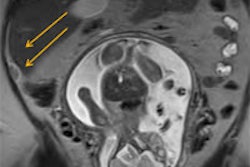Proper training and guidance from more-experienced radiologists can improve the diagnostic accuracy of less-experienced readers in evaluating abdominal MR images for acute appendicitis, according to a study published online June 14 in Radiology.
Not only did sensitivity for radiologists and residents improve significantly for detecting appendicitis after training, but study participants also completed their interpretations faster, according to a Dutch team led by Dr. Marjolein Leeuwenburgh from the University of Amsterdam.
The researchers took 100 consecutive MRI exams of patients with suspected appendicitis who were examined in the emergency department of the Alkmaar Medical Center in the Netherlands between December 2007 and January 2010. The 100 cases consisted of 68 women (mean age, 28 years) and 32 men (mean age, 31 years) (Radiology, June 14, 2012).
The 100 patients had received 1.5-tesla MRI scans (Magnetom Avanto, Siemens Healthcare) in supine position with no oral or intravenous contrast material enhancement after ultrasound results proved inconclusive or negative.
Leeuwenburgh and colleagues then invited radiologists and residents from two university hospitals and five teaching hospitals with no experience in evaluating MR images for acute abdominal conditions to participate in the study. In all, nine radiologists and eight residents completed the training program between March 2010 and January 2011.
The radiologists had an average of 15 years of experience, ranging from seven to 25 years, and all nine participants had evaluated images from more than 1,000 abdominal CT examinations for acute conditions. Eight of the nine radiologists had experience evaluating images from more than 1,000 MRI exams in general, but none had experience with MRI evaluation for acute abdominal conditions.
The residents had an average experience of three years (range, two to five), with fewer than 1,000 abdominal CT evaluations and fewer than 1,000 MRI interpretations, none of which were for acute abdominal conditions.
Training program
The training program consisted of an introduction to conventional MRI and diffusion-weighted MRI without the use of contrast to evaluate acute appendicitis and 53 slides with a brief explanation of both conventional MRI and diffusion-weighted MRI. MR images from 17 patients with suspected appendicitis were also presented.
The readers were then asked to examine the series of images from 100 MRI scans and note their findings. Clinical information, including patient history and physical examination and laboratory findings, was available for all patients.
The readers were also asked to assign their level of confidence, based on a scale of one to 10, for positive and negative diagnoses. After each case, they could verify their diagnosis by checking the reference standard, which contained the diagnosis and details of the clinical MRI results.
Reading time per case was measured in minutes and seconds with a digital clock and was recorded by the participants.
Greater sensitivity
After the training program, sensitivity for the average reader for detecting appendicitis improved significantly (0.82 versus 0.92, p = 0.003), while the improvement in specificity was not significant (0.82 versus 0.88, p = 0.10).
Sensitivity for radiologists increased from 81% in the first set of 25 cases to 91% in the last set, while specificity improved from 82% to 85%, respectively. For residents, sensitivity increased from 82% to 94%, while specificity improved from 82% to 91%, respectively.
Sensitivity improved from 80% to 87% in all readings combined when diffusion-weighted images were read in addition to conventional MRI.
In addition, the radiologists were also able to complete their tasks faster. The mean reading time for radiologists decreased significantly from five minutes, eight seconds, per image in the first set to three minutes, 28 seconds, in the last set of 25 cases. The reading times for residents decreased from seven minutes, 50 seconds, to five minutes, 23 seconds, per case.
"Radiologists and residents with no experience in evaluating MR images of patients suspected of having appendicitis can be trained to reach a diagnostic accuracy level comparable to that of readers of computed tomographic abdominal images for appendicitis," Leeuwenburgh and colleagues concluded.
"Similar training programs can be provided to all inexperienced readers before they evaluate MR images of patients suspected of having acute appendicitis," they wrote.


.fFmgij6Hin.png?auto=compress%2Cformat&fit=crop&h=100&q=70&w=100)





.fFmgij6Hin.png?auto=compress%2Cformat&fit=crop&h=167&q=70&w=250)











